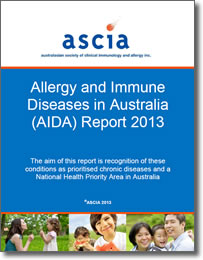Allergy and Immune Diseases in Australia (AIDA) Report 2013
![]() Allergy and Immune Diseases in Australia (AIDA) Report 2013720.33 KB
Allergy and Immune Diseases in Australia (AIDA) Report 2013720.33 KB
 The aim of the AIDA report is recognition of these conditions as prioritised chronic diseases and a National Health Priority Area in Australia.
The aim of the AIDA report is recognition of these conditions as prioritised chronic diseases and a National Health Priority Area in Australia.
Fast Facts
What are the current problems?
1. Allergy and immune diseases (immunodeficiency and autoimmune diseases) are among the fastest growing chronic conditions in Australia.
2. Almost 20% of the Australian population has an allergic disease and this prevalence is increasing.
3. Hospital admissions for anaphylaxis (severe life threatening allergic reaction) have increased 4 fold in the last 20 years.
4. Food-induced anaphylaxis has doubled in the last 10 years and 10% of infants now have an immediate food allergy.
5. Immunodeficiency diseases are serious, potentially life threatening conditions that are increasing in number and complexity.
6. Delay in diagnosis of immunodeficiency disease leads to poor health outcomes and premature death.
7. Autoimmune diseases affect 5% of Australians and are more common than cancer or heart disease.
8. There are over 100 different autoimmune diseases that affect Australians and lead to significant disability.
9. There is a lack of public awareness about the impact and appropriate management of allergy and immune diseases.
10. Access to care is difficult, even in metropolitan areas, due to the high number of patients and low number of appropriately trained health care professionals, resulting in long waiting times to see a specialist.
What are the solutions?
1. Allergy and immune disease should be recognised as one of the most important chronic disease groups in Australia, which will:
- Enable projects relating to these diseases to be eligible to apply for grants specific for chronic diseases.
- Improve management and prevention strategies for these diseases.
2. Development of a national allergy and immune diseases model of care which will address:
- Improved access to care and accurate diagnosis for patients with allergic and immune diseases.
- Access to affordable and cost-effective therapies.
For more information see full report.
Content updated July 2013
